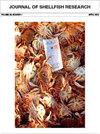Spatio-Temporal Variation of the Abundance of Pearl Oyster (Pinctada mazatlanica) Spat and Its Relevance in the Location of Suitable Sites for Extensive Pearl Oyster Culture
IF 1
4区 农林科学
Q3 FISHERIES
引用次数: 1
Abstract
ABSTRACT In general, pearl cultivation has advanced with organisms produced and improved in hatchery; however, wild spat collection is still the primary source for commercial cultivation. In Mexico, progress toward pearl oyster hatchery spat production is yet in the experimental stage. The only three farms established in the country (Guaymas, La Paz, and Cozumel Island) rely on extensive culture. Constant spat supply is imperative to ensure a successful operation; at La Paz Bay, however, larval uptake of the pearl oyster Pinctada mazatlanica in artificial collectors has always been low. This study aimed to assess spatio-temporal and bathymetric patterns of spat distribution across the area to locate suitable sites to install spat collecting stations. Our results showed significant differences (P < 0.05) between stations. Mogote, Caimancito, Punta Colorada, and Gaviota Island were the stations with the highest spat abundance at 1-m depth in July–September after 40 and 60 days of immersion. The data were also analyzed with generalized linear models. The best models, selected with the Akaike and Bayesian criteria, suggest that 1-m depth, 40- and 60-day immersion time, and site (particularly, Caimancito Beach, Punta Colorada, and Gaviota Island) contributed significantly to explaining the highest catches (mean: 5–8 organisms/collector) of P. mazatlanica spat in La Paz Bay. Therefore, the area within these sites should be considered suitable for installing the network of artificial collectors during the season of high spat abundance.珍珠牡蛎(Pinctada mazatlanica)丰度的时空变化及其与广泛养殖珍珠牡蛎适宜地点的相关性
摘要:总的来说,珍珠养殖已经随着孵化场生产和改进的生物而进步;然而,野生唾沫采集仍然是商业种植的主要来源。在墨西哥,珍珠牡蛎孵化场生产的进展尚处于试验阶段。该国仅有的三个农场(瓜伊玛斯、拉巴斯和科祖梅尔岛)依靠广泛的文化。持续的吐口水供应是确保运营成功的必要条件;然而,在拉巴斯湾,人工采集的珍珠牡蛎Pinctada mazatlanica的幼虫吸收率一直很低。本研究旨在评估该地区唾沫分布的时空和水深模式,以确定合适的地点安装唾沫收集站。我们的结果显示,各站之间存在显著差异(P<0.05)。Mogote、Caimacito、Punta Colorada和Gaviota Island是经过40天和60天浸泡后,7-9月1米深度的唾沫丰度最高的站点。数据也用广义线性模型进行了分析。根据Akaike和Bayesian标准选择的最佳模型表明,1米的深度、40天和60天的浸泡时间和地点(特别是Caimacito海滩、Punta Colorada和Gaviota岛)对解释拉巴斯湾马扎特拉尼卡蟾蜍的最高捕获量(平均值:5-8个生物体/收集器)有重要作用。因此,这些地点内的区域应被认为适合在唾沫丰度高的季节安装人工收集器网络。
本文章由计算机程序翻译,如有差异,请以英文原文为准。
求助全文
约1分钟内获得全文
求助全文
来源期刊

Journal of Shellfish Research
生物-海洋与淡水生物学
CiteScore
2.30
自引率
0.00%
发文量
40
审稿时长
6 months
期刊介绍:
Original articles dealing with all aspects of shellfish research will be considered for publication. Manuscripts will be judged by the editors or other competent reviewers, or both, on the basis of originality, content, merit, clarity of presentation, and interpretations.
 求助内容:
求助内容: 应助结果提醒方式:
应助结果提醒方式:


